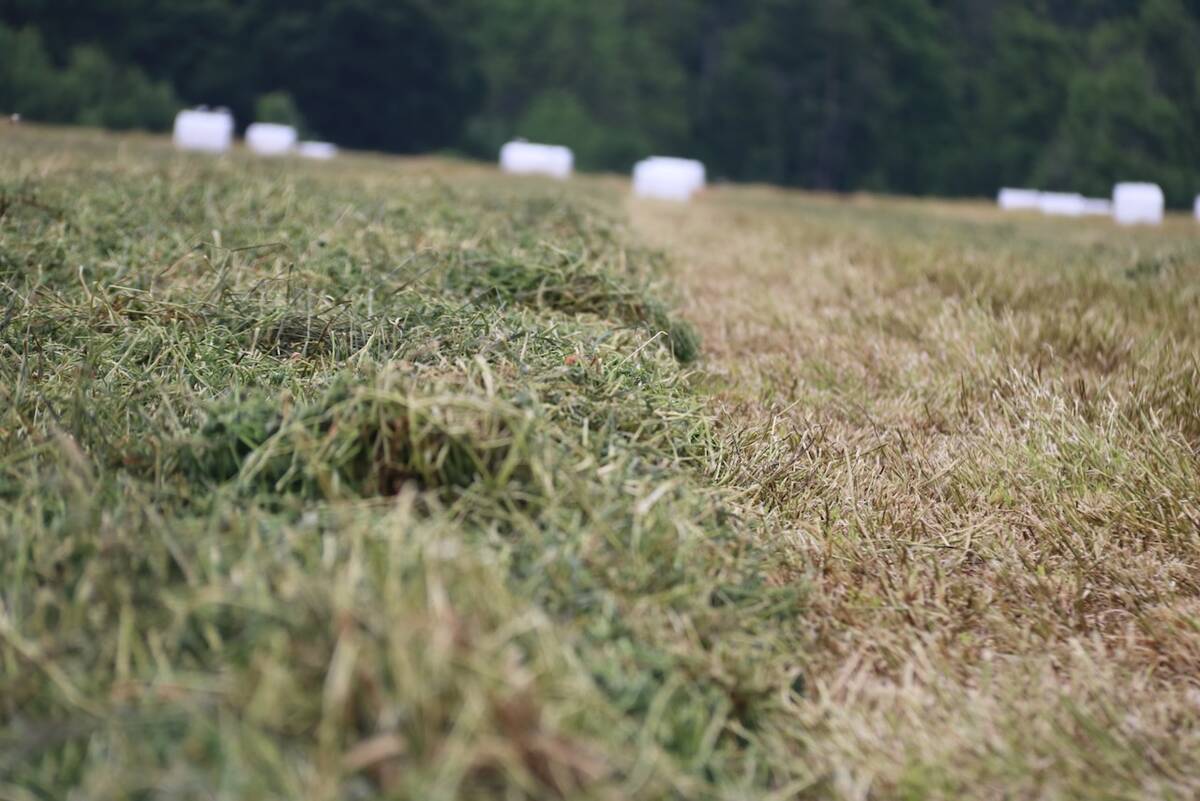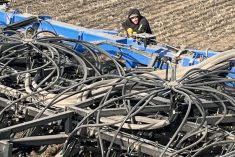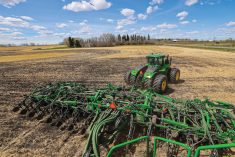Trent Duczek of Grayson, Sask. and Caleb Wierenga of Neerlandia, Alta. both agree that silence is not golden when it comes time to seeding the crop, but both have become big believers in an acoustic-based flow monitoring system using sound — or the lack of it — on their air drills that quickly tells them when something isn’t running right.
The two grain, oilseed and pulse crop producers are among the early users of the Intelligent Agricultural Solutions (IAS) wireless blockage and flow monitoring system. Relatively simple to install on just about any air seeding system using dry products (seed and fertilizer), the IAS system relies on sound through the manifold and the individual hoses of the air seeder to alert the operator if there is a blockage or even a slow down in the flow of seed or fertilizer.
Read Also

New high-performance forage training program to launch in 2026
A new Canadian Forage and Grasslands Asssociation high-performance forage program will be a resource for farmers, agronomists and others in the forage sector.
Small microphones or “stethoscopes” installed on each run of the air seeding hoses send messages wirelessly through a WiFi network to an iPad in the tractor cab, immediately telling the operator where there is some blockage or slow down and in which numbered hose. If the microphone doesn’t hear the sound of seed or fertilizer moving, or even detects a reduced flow it sends a signal.
Did the job
“I am just really impressed at how well it works,” says Caleb Wierenga who farms with family north of Edmonton. He installed one system on a 64-foot Seed Hawk air drill in 2013 and has outfitted a second 52-foot drill with the flow monitoring system for the 2014 seeding season.
“It not only told me when there was a blockage in the hoses, but it even alerted me to the fact that one tower (manifold) was delivering 20 per cent less seed than the targeted seeding rate. It looked like everything was working, but you can’t see 20 per cent less flow with the naked eye. The monitor told us the flow was reduced by 20 per cent and sure enough, we took the manifold apart and there was a blockage.”
Trent Duczek, by coincidence also installed the IAS wireless flow monitor on a 60-foot Seed Hawk drill in 2013 to seed canola, wheat, canary seed, and peas on his farm just south of Melville, Sask.
“It is just a very consistent flow monitoring system that alerts you any time there is a blocked run and even lets you know if the fan speed is too low in one section,” says Duczek.
Even when seeding on a side hill, the flow monitor has a plus or minus indicator system that advises Duczek if there is a reduced flow of seed and fertilizer through the runs on the upslope and heavier flow through the runs on the down slope.
Both farmers had become frustrated with the original flow monitoring systems on their seeding systems that used optical sensors to measure the flow of seed and fertilizer.
“It was a hardwired system and it was just very hit and miss,” says Duczek. “You couldn’t trust it.” Wierenga’s comments were similar. “The system we had used was an electronic eye on each hose and really it worked terrible,” he says. “It would give me all these false positives and then when the crop emerged there would be these blank seed rows in the field.”
Several blockage causes
Any number of factors can affect seed and fertilizer flow, say the farmers. Equipment failure, high humidity, muddy field conditions which blocks openers, and fertilizer clumps are among the leading causes. “It never seemed to fail,” says Wierenga. “I’d refill the seed tank, check to make sure all the runs are working and then I’d only go a short distance and something would plug, so you need to be able to monitor it closely.”
Intelligent Agricultural Solutions based in Fargo, North Dakota launched the wireless blockage and flow monitor system in 2011, says Bobby Volesky, product manager.
“Every seeding system manufacturer either has their own flow monitoring system or uses and after-market product,” he says. “And they all operate with optical eyes or infrared sensors. And they are all wired systems. Whether you have 40 or 120 hoses or more you are faced with this complex wiring system.”
Other than the main IAS power cable, all information is transmitted wirelessly through an on-board WiFi system from the sensors to the iPad in the tractor cab. Volesky says no added cellular service is needed, the system is self-contained and can transmit up to 270 feet which should even accommodate seeding systems with tow-between carts.
From the Manitoba Co-operator website: Farmer inventions showcased at Manitoba Ag Days
Easy to install
The monitoring system is delivered as a kit. “I have never been as impressed with an after market kit as I was with this one,” says Wierenga. “It has absolutely everything you need (except the iPad), comes with easy instructions that cover every scenario… it is complete.”
Duczek says he installed 95 per cent of the system himself, but had Saskatchewan sales rep Zane Zolinski of Saskatoon come by the farm to make a final check that everything was working properly. Wierenga says he just followed instructions and everything worked as planned. Both farmers say on the 60-plus foot systems, brackets, power cable, manifold sensor boards and microphones in each hose can be installed in less than a day.
IAS can supply the iPad as well, but Volesky says they encourage farmers to buy their own. Once they have the iPad, producers download the IAS app and are ready to use the monitoring system.
The small microphones have to be installed in each seed and fertilizer tube as it leaves the manifold on the air seeding system. As seed leaves the manifold and enters the sensor it impacts a stainless steel membrane, causing a small pulse of sound. Those pulses are transferred through a tube to the ECU (electronic control unit) board, which converts all the analog audio pulses into digital signals and transmits them wirelessly to the iPad.
The IAS iPad app displays the system status at a glance and detects a blockage anywhere in the system. The flow monitor also displays total flow levels and flow variance from manifold to manifold. There is also an option for the operator to use multiple product types and rates through dual-shooting or mid-row banders.
Volesky says the flow monitor works with all airseeding systems equipped with hoses ranging from 7/8 to 1-1/2 inch diameter.
Cost wise, both Duczek and Wierenga say the system isn’t cheap, although price competitive. “It may have cost a bit more than other systems, but the fact that actually works is worth a lot,” says Duczek.
Volesky says with dealers and distributors in Canada, the flow monitoring system costs about $500 per tower (or manifold) for each ECU board and each sensor for each opener costs $80. For a smaller 40 foot drill with four towers the system would cost about $6,000 and for a larger air seeding system with 80 openers and more the cost will be about $10,000 and up depending on the size of the drill.
For more information on the IAS wireless flow monitor visit the company website at www.intelligentag.com.
Lee Hart is a field editor for Grainews in Calgary. Contact him at 403-592-1964 or by email at [email protected].
















